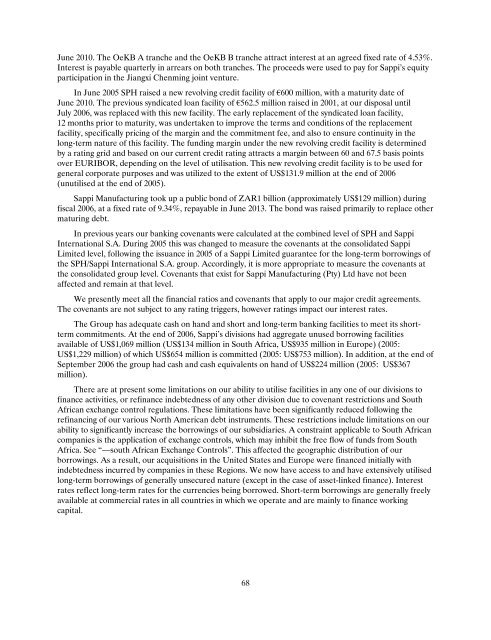Create successful ePaper yourself
Turn your PDF publications into a flip-book with our unique Google optimized e-Paper software.
June <strong>20</strong>10. The OeKB A tranche and the OeKB B tranche attract interest at an agreed fixed rate of 4.53%.<br />
Interest is payable quarterly in arrears on both tranches. The proceeds were used to pay for <strong>Sappi</strong>’s equity<br />
participation in the Jiangxi Chenming joint venture.<br />
In June <strong>20</strong>05 SPH raised a new revolving credit facility of €600 million, with a maturity date of<br />
June <strong>20</strong>10. The previous syndicated loan facility of €562.5 million raised in <strong>20</strong>01, at our disposal until<br />
July <strong><strong>20</strong>06</strong>, was replaced with this new facility. The early replacement of the syndicated loan facility,<br />
12 months prior to maturity, was undertaken to improve the terms and conditions of the replacement<br />
facility, specifically pricing of the margin and the commitment fee, and also to ensure continuity in the<br />
long-term nature of this facility. The funding margin under the new revolving credit facility is determined<br />
by a rating grid and based on our current credit rating attracts a margin between 60 and 67.5 basis points<br />
over EURIBOR, depending on the level of utilisation. This new revolving credit facility is to be used for<br />
general corporate purposes and was utilized to the extent of US$131.9 million at the end of <strong><strong>20</strong>06</strong><br />
(unutilised at the end of <strong>20</strong>05).<br />
<strong>Sappi</strong> Manufacturing took up a public bond of ZAR1 billion (approximately US$129 million) during<br />
fiscal <strong><strong>20</strong>06</strong>, at a fixed rate of 9.34%, repayable in June <strong>20</strong>13. The bond was raised primarily to replace other<br />
maturing debt.<br />
In previous years our banking covenants were calculated at the combined level of SPH and <strong>Sappi</strong><br />
International S.A. During <strong>20</strong>05 this was changed to measure the covenants at the consolidated <strong>Sappi</strong><br />
Limited level, following the issuance in <strong>20</strong>05 of a <strong>Sappi</strong> Limited guarantee for the long-term borrowings of<br />
the SPH/<strong>Sappi</strong> International S.A. group. Accordingly, it is more appropriate to measure the covenants at<br />
the consolidated group level. Covenants that exist for <strong>Sappi</strong> Manufacturing (Pty) Ltd have not been<br />
affected and remain at that level.<br />
We presently meet all the financial ratios and covenants that apply to our major credit agreements.<br />
The covenants are not subject to any rating triggers, however ratings impact our interest rates.<br />
The Group has adequate cash on hand and short and long-term banking facilities to meet its shortterm<br />
commitments. At the end of <strong><strong>20</strong>06</strong>, <strong>Sappi</strong>’s divisions had aggregate unused borrowing facilities<br />
available of US$1,069 million (US$134 million in South Africa, US$935 million in Europe) (<strong>20</strong>05:<br />
US$1,229 million) of which US$654 million is committed (<strong>20</strong>05: US$753 million). In addition, at the end of<br />
September <strong><strong>20</strong>06</strong> the group had cash and cash equivalents on hand of US$224 million (<strong>20</strong>05: US$367<br />
million).<br />
There are at present some limitations on our ability to utilise facilities in any one of our divisions to<br />
finance activities, or refinance indebtedness of any other division due to covenant restrictions and South<br />
African exchange control regulations. These limitations have been significantly reduced following the<br />
refinancing of our various North American debt instruments. These restrictions include limitations on our<br />
ability to significantly increase the borrowings of our subsidiaries. A constraint applicable to South African<br />
companies is the application of exchange controls, which may inhibit the free flow of funds from South<br />
Africa. See “—south African Exchange Controls”. This affected the geographic distribution of our<br />
borrowings. As a result, our acquisitions in the United States and Europe were financed initially with<br />
indebtedness incurred by companies in these Regions. We now have access to and have extensively utilised<br />
long-term borrowings of generally unsecured nature (except in the case of asset-linked finance). Interest<br />
rates reflect long-term rates for the currencies being borrowed. Short-term borrowings are generally freely<br />
available at commercial rates in all countries in which we operate and are mainly to finance working<br />
capital.<br />
68
















